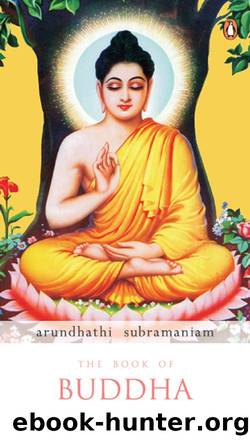The Book of Buddha by Arundhati Subramaniam

Author:Arundhati Subramaniam [Subramaniam, Arundhati]
Language: eng
Format: epub
ISBN: 9780143067658
Publisher: Penguin Books Ltd
Published: 2009-06-16T00:00:00+00:00
Without Tarrying, Without Hurrying
The life of the Buddha, unlike that of many great saints, is not a catalogue of flamboyant miracles. Would miracles have won him more converts? Perhaps. But for the wrong reasons, and the Buddha reveals a strong distaste for the use of manipulative means to swell his constituency. He refused to use psychic gifts or paranormal powers to heal the sick, raise the dead or uplift the weak. This, he held, could only foster a jingoistic faith, a blind self-abnegation rather than a spiritual conviction of any depth or discernment. At the Pavarika Grove in Nalanda, a householderâs son, Kevadha, suggested that the Tathagata appoint a monk to work a miracle so that Nalandaâs faith in the Dharma might increase. The Sage replied that though he did possess certain supernormal powers, he was no more than a magician if he used them merely to impress people. More importantly, they offered no enduring escape from the central human problem: suffering. The only power he was prepared to use was the âmarvel of guidanceââspiritual instructionâsince this served the higher objective of leading seekers to the other shore.
Once in Kosambi, the Master picked up a handful of leaves and asked the monks what was more plentifulâthe leaves in his hand or those on the trees. Those in the forest, replied the monks. So also, said the Buddha, the things that I have known by direct knowledge are far more than what I have taught. Why did he withhold some aspects of knowledge? The familiar answer: âBecause they bring no benefit, they do not lead to the cessation of suffering, to nirvana.â
The Buddhaâs mistrust of miracle-mongering extended to an impatience with superstition and hollow convention as well. A humorous account relates how when the Teacher sneezed in the middle of a sermon, the monks chorused the conventional response: âLong life to you, Lord.â The rational Master, vexed at the interruption, forbade the custom on the grounds that it was a mere tokenism. Later, however, when disapproving householders complained that the alms-gathering monks did not make the polite observance, the Buddha revoked his decision and permitted them to continue the practice.
Many of the Tathagataâs listeners found their entire world view transformed in a single stroke by a deceptively simple insight, a spontaneous parable, or a seemingly minor clarification of doctrine. As did the wanderer Dighanakha, who informed the Buddha that he espoused a theory of non-attachment, having âno liking for anythingâ. The Buddha listened patiently, then gently drew his attention to the subtle egotism of this stanceâfor even attachment to this intellectual position was a type of grasping, born of a need to retain some marker of identity. âThe Dispassionate One disputes with none and sides with none,â declared the Master. On hearing this, Shariputra, his prime disciple, attained enlightenment and Dighanakha was inspired to join the fold.
Fundamental to the Tathagataâs teaching was the maintenance of a creative tension between the extremes of self-mortification and self-indulgence. As the Buddha had anticipated, this delicate balance was not always an easy one to maintain, particularly for the new aspirant.
Download
This site does not store any files on its server. We only index and link to content provided by other sites. Please contact the content providers to delete copyright contents if any and email us, we'll remove relevant links or contents immediately.
The Compleat Magical Path Magic Lessons by John Cross(394)
The Return of the Dragon : The Shocking Way Drugs and Religion Shape People and Societies by Lewis Ungit(376)
THEM: They Come at Night by Tom Lyons(366)
Dogme et Rituel de la Haute Magie Part I by Eliphas Levi(353)
The Mind at Large: Clairvoyance, Psychics, Police and Life after Death: A Polish Perspective by Weaver Zofia & Janoszka Krzysztof(347)
Strange Tricks by Syd Moore(342)
Shaman: The Mysterious Life and Impeccable Death of Carlos Castaneda by Mike Sager(332)
The Iron Republic by Richard Jameson Morgan(330)
101 Ways to Jump-Start Your Intuition by John Holland(327)
Psychic Secrets by Jade-Sky(326)
Kabbalah and Sex Magic by Marla Segol(320)
Haunted Ships: True Paranormal Ghost Ship Stories by Press Chronicle(320)
Cult Cinema: A Personal Exploration of Sects, Brainwashing and Bad Religion in Film and Television by Ingham Howard(318)
The Bonds That Bind by K. J. Lavallee(315)
Kickstart My Witch (Witch's Guide to Haunted Properties: Los Angeles: Mystery Book 1) by Lotta Smith(305)
Evil Unleashed: True Tales of Spells Gone to Hell and Other Occult Disasters by John Harker(300)
The Satanism Scare by Joel Best(297)
The Blood Electric: Nephilim Unbound 5 by Jason Caldwell(295)
The Airmen Who Would Not Die by Fuller John G(291)
